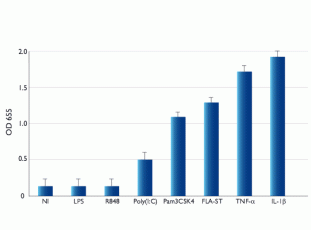A549-Dual™ Cells
-
Cat.code:
a549d-nfis
- Documents
ABOUT
Human NF-κB-SEAP & IRF-Luc Reporter lung carcinoma
A549-Dual™ cells are adherent epithelial cells that have been derived from the human A549 lung carcinoma cell line by stable integration of two inducible reporter constructs. The A549 cell line is a well-characterized cellular model for asthma, allergies and respiratory infections.
A549-Dual™ cells express a secreted embryonic alkaline phosphatase (SEAP) reporter gene under the control of the IFN-β minimal promoter fused to five NF-κB binding sites.
A549-Dual™ cells also express the Lucia luciferase gene, which encodes a secreted luciferase, under the control of an ISG54 minimal promoter in conjunction with five IFN-stimulated response elements.
As a result, A549-Dual™ cells allow to simultaneously study the NF-κB pathway, by assessing the activity of SEAP, and the interferon regulatory factor (IRF) pathway, by monitoring the activity of Lucia luciferase.
Both reporter proteins are readily measurable in the cell culture supernatant when using QUANTI-Blue™ Solution, a SEAP detection reagent, and QUANTI-Luc™ 4 Lucia/Gaussia, a Lucia and Gaussia luciferase detection reagent.
Disclaimer: These cells are for internal research use only and are covered by a Limited Use License (See Terms and Conditions). Additional rights may be available.
SPECIFICATIONS
Specifications
Screening of PRR agonists or inhibitors
Complete DMEM (see TDS)
Verified using Plasmotest™
Each lot is functionally tested and validated.
CONTENTS
Contents
-
Product:A549-Dual™ Cells
-
Cat code:a549d-nfis
-
Quantity:3-7 x 10^6 cells
- 1 ml of Zeocin® (100 mg/ml)
- 1 ml of Blasticidin (10 mg/ml)
- 1 ml of Normocin® (50 mg/ml)
- 1 tube of QUANTI-Luc™ 4 Reagent (Lucia luciferase detection reagent)
- 1 ml of QB reagent and 1 ml of QB buffer (SEAP detection reagent)
Shipping & Storage
- Shipping method: Dry ice
- Liquid nitrogen
- Avoid repeated freeze-thaw cycles
Storage:
Caution:
DOCUMENTS
Documents
Technical Data Sheet
Validation Data Sheet
Safety Data Sheet
Certificate of analysis
Need a CoA ?

